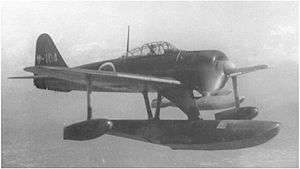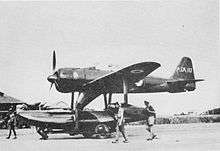Nakajima A6M2-N
| A6M2-N | |
|---|---|
 | |
| A6M2-N | |
| Role | Interceptor/Fighter-bomber |
| Manufacturer | Nakajima Aircraft Company |
| First flight | 7 December 1941 |
| Introduction | 1942 |
| Primary user | Imperial Japanese Navy |
| Number built | 327 |
| Developed from | Mitsubishi A6M Zero |
The Nakajima A6M2-N (Navy Type 2 Interceptor/Fighter-Bomber) was a single-crew float seaplane based on the Mitsubishi A6M Zero Model 11. The Allied reporting name for the aircraft was Rufe.
Design and development
The A6M2-N floatplane was developed from the Mitsubishi A6M Zero Type 0, for the purposes of supporting amphibious operations and defending remote bases. It was based on the A6M-2 Model 11 fuselage, with a modified tail and added floats. This aircraft was the brainchild of Shinobu Mitsutake, Nakajima Aircraft Company's Chief Engineer, and Atsushi Tajima, one of the company's designers. A total of 327 were built, including the original prototype.
Operational history
The aircraft was deployed in 1942, referred to as the "Suisen 2" ("Hydro fighter type 2"), and was only utilized in defensive actions in the Aleutians and Solomon Islands operations. Such seaplanes were effective in harassing American PT boats at night, and they were very difficult to detect, even with primitive radar. Close misses killed officers and crews of boats such as PT 105. They could also drop flares to illuminate the PTs which were vulnerable to destroyer gunfire, and depended on cover of darkness. Since the boats left a phosphorescent wake which was visible from the air, they would leave their engines in idle to minimize this. It was primarily for this reason that John F. Kennedy's PT 109 was caught off guard in idle and rammed by the destroyer Amagiri, unable to maneuver out of the way in time.

The seaplane also served as an interceptor for protecting fueling depots in Balikpapan and Avon Bases (Dutch East Indies) and reinforced the Shumushu base (North Kuriles) in the same period. Such fighters served aboard seaplane carriers Kamikawa Maru in the Solomons and Kuriles areas and aboard Japanese raiders Hokoku Maru and Aikoku Maru in Indian Ocean raids. In the Aleutian Campaign this fighter engaged with RCAF Curtiss P-40, Lockheed P-38 Lightning fighters and Boeing B-17 Flying Fortress bombers. The aircraft was used for interceptor, fighter-bomber, and short reconnaissance support for amphibious landings, among other uses.
Later in the conflict the Otsu Air Group utilized the A6M2-N as an interceptor alongside Kawanishi N1K1 Kyofu ("Rex") aircraft based in Biwa lake in the Honshū area.
The last A6M2-N in military service was a single example recovered by the French forces in Indochina after the end of World War II. It crashed shortly after being overhauled.[1]
The large float and wing pontoons of the A6M2-N degraded its performance by about 20%, enough that the A6M2-N was not usually a match for even the first generation of Allied fighters.
Operators


- Imperial Japanese Navy Air Service
- Yokohama Air Group
- Toko Air Group
- Otsu Air Group
- Yokosuka Air Group (technical evaluation unit)
- 11th Air Fleet
- 5th Air Fleet
- 36th Air Fleet
- 452nd Air Fleet
- 934th Air Fleet
- French Navy - Postwar, one Nakajima A6M-2N was captured in Indo-China, it was impressed into service with the French Navy in late 1945.
Specifications (Nakajima A6M2-N)

Data from Japanese Aircraft of the Pacific War [2]
General characteristics
- Length: 10.10 m (33ft 1⅝ in)
- Wingspan: 12.00 m (39 ft 4⅜ in)
- Height: 4.30 m (14ft 1⅜ in)
- Wing area: 22.44 m² (251.4 sq ft)
- Empty weight: 1,912 kg (4,235 lb)
- Loaded weight: 2,460 kg (5,423 lb)
- Max. takeoff weight: 2,880 kg (6,349 lb)
- Powerplant: 1 × Nakajima NK1C Sakae 12 air cooled 14 cylinder radial engine, 950 hp (709 kW) at 4,200 m (13,800 ft)
Performance
- Maximum speed: 436 km/h (235 knots, 270.5 mph) at 5,000 m (16,400 ft)
- Cruise speed: 296 km/h (160 knots, 184 mph)
- Range: 1,782 km (963 nmi, 1,107 mi)
- Service ceiling: 10,000 m (32,800 ft)
- Climb rate: 6 min 43 s to 5,000 m (16,400 ft)
Armament
- Guns:
- 2 × 7.7 mm Type 97 machine guns in forward fuselage
- 2 ×20 mm Type 99 cannons -fixed in outer wings
- Bombs: 2 × 60 kg (132 lb) bombs
See also
- Related development
- Aircraft of comparable role, configuration and era
- Bernard H 110
- Dewoitine D.520
- Grumman F4F-3S Wildcatfish
- Kawanishi N1K1 Kyōfū
- Loire 210
- Supermarine Spitfire floatplanes
- Related lists
- List of aircraft of Japan during World War II
- List of aircraft of World War II
- List of fighter aircraft
- List of military aircraft of Japan
References
Bibliography
- Dorr, Robert F. and Chris Bishop. Vietnam Air War Debrief. London:Aerospace |Publishing, 1996. ISBN 1-874023-78-6.
- Francillon, R.J. Japanese Aircraft of the Pacific War. London:Putnam, 1970. ISBN 0-370-00033-1.
- Green, William. War Planes of the Second World War, Volume Six: Floatplanes. London: Macdonald & Co., (Publishers) Ltd., 1962.
- Green, William and Gordon Swanborough. The Complete Book of Fighters. New York: Smithmark, 1994. ISBN 0-8317-3939-8.
- Jackson, Robert. Combat Legend: Mitsubishi Zero. Ramsbury, Marlborough, Wiltshire, UK: Airlife Publishing, 2003. ISBN 1-84037-398-9.
- Janowicz, Krzystof. Mitsubishi A6M2-N Rufe (Kagero Famous Airplanes 4) (in Polish/English). Lublin, Poland: Kagero, 2004. ISBN 83-89088-42-8.
- Mikesh, Robert C. Warbird History: Zero, Combat & Development History of Japan's Legendary Mitsubishi A6M Zero Fighter. Osceola, Wisconsin: Motorbooks International, 1994. ISBN 0-87938-915-X.
- Sakaida, Henry. Imperial Japanese Navy Aces, 1937–45. Botley, Oxford, UK: Osprey Publishing Ltd., 1999. ISBN 1-85532-727-9.
- Gunston,Bill. The Illustrated Encyclopedia of Combat Aircraft of World War II. London, UK: Salamander Books Ltd., 1978 ISBN 0-89673-000-X
External links
![]() Media related to Nakajima A6M2-N Rufe at Wikimedia Commons
Media related to Nakajima A6M2-N Rufe at Wikimedia Commons